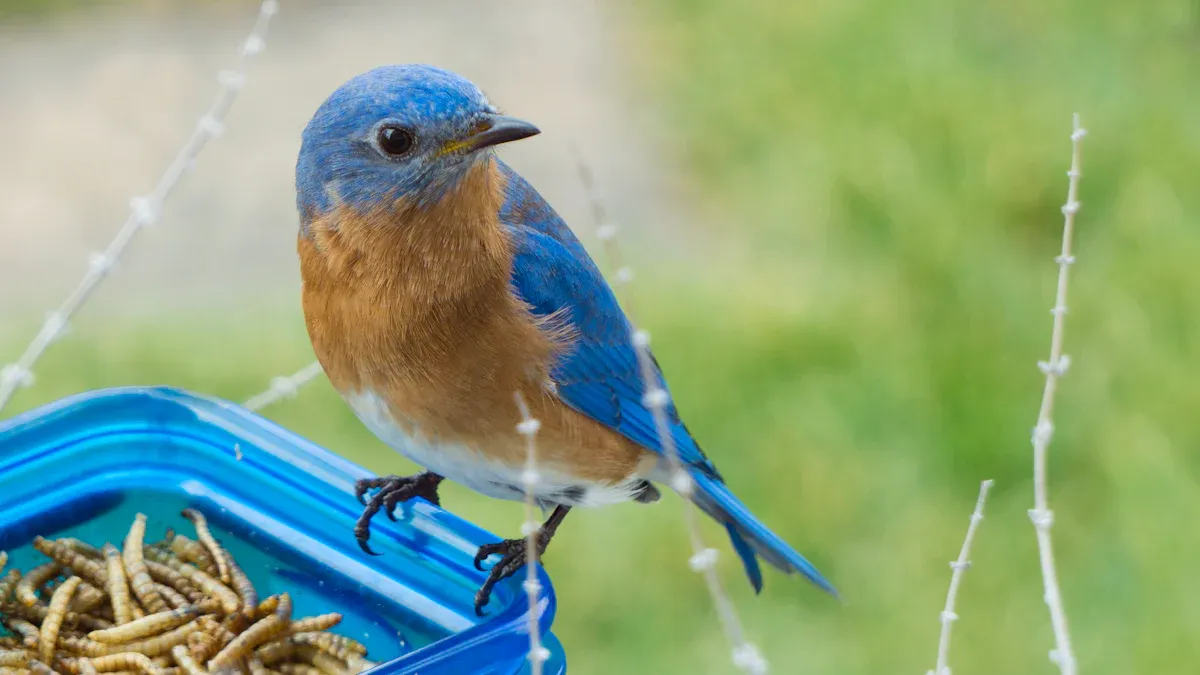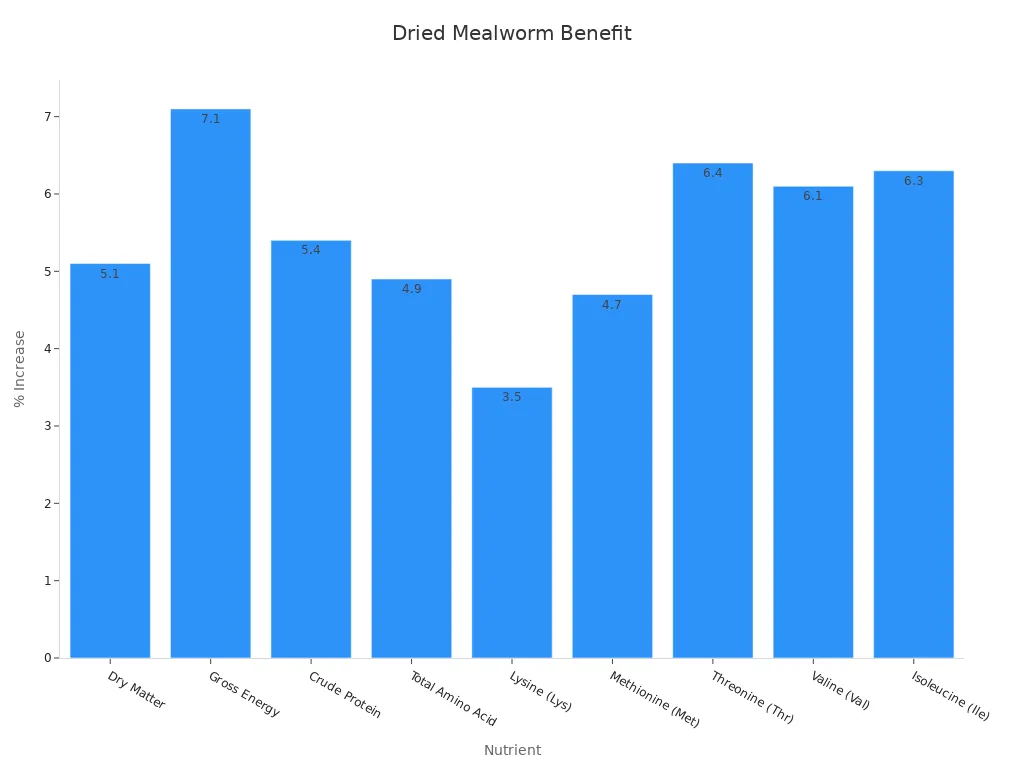
Dried Mealworms give pets a protein boost, with levels reaching up to 56 g per 100 g. Many birds, reptiles, and small mammals thrive on this nutrient-rich treat. Recent trends show more pet owners choosing dried mealworms for their convenience, shelf life, and positive effects on pet health.
Key Takeaways
- Dried mealworms give pets lots of protein and good fats.
- These help pets grow, have energy, and stay healthy.
- Birds, reptiles, and small mammals like dried mealworms most.
- Mealworms help pets feel better and act naturally.
- Give dried mealworms as a treat, but not too much.
- Store them the right way and pick good brands.
- This keeps your pets safe and healthy.
Dried Mealworms: Nutritional Benefits and Suitability
Protein, Fats, and Essential Nutrients in Dried Mealworms
Dried Mealworms pack a powerful punch when it comes to nutrition. They offer a rich source of protein and healthy fats, which help pets grow strong and stay active. The drying process doubles the concentration of nutrients compared to fresh larvae, making them even more valuable for your pet’s diet.
Here’s a quick look at what 100 grams of dried mealworms provide:
| Nutrient | Amount per 100g dried mealworm (approximate) |
|---|---|
| Protein | ~36% |
| Fat | ~44% |
| Ash | ~3.1% |
| Magnesium | 87.5 mg |
| Zinc | 4.2 mg |
| Iron | 3.8 mg |
| Copper | 0.78 mg |
| Manganese | 0.44 mg |
| n-6/n-3 Fatty Acid Ratio | 6.76 |

These nutrients support muscle growth, energy, and a healthy immune system. The high protein content is especially important for pets during times of growth or recovery. The healthy fats help keep skin and fur shiny, while minerals like iron and zinc boost overall health.
Which Pets Benefit Most from Dried Mealworms
Many pets enjoy and benefit from Dried Mealworms. Birds, reptiles, and small mammals all see improvements in health when mealworms become part of their diet.
- Birds: Mealworms help birds grow strong feathers and stay energetic. They also support the immune system and encourage natural foraging, which keeps birds mentally active. Robins, in particular, love mealworms and will flock to any feeding station that offers them. Even wildfowl at the local pond benefit from mealworms as a healthier alternative to bread.
- Reptiles: Reptiles get a boost in growth and energy. The crunchy texture helps with dental health, and hunting for mealworms provides mental stimulation.
- Small Mammals: Small pets like hamsters and hedgehogs gain balanced protein, calcium for bones and teeth, and iron for healthy blood. These nutrients improve their immune system, digestion, and coat quality.
Tip: The freeze-dried process keeps all the good stuff inside, making Dried Mealworms a natural and convenient treat for pets.
Studies show that pets digest mealworm protein very well. For example, research on chickens and tilapia found that adding mealworms to their diets improved growth and nutrient absorption. In dogs and cats, mealworm protein scores are similar to or better than many traditional animal proteins.
Why Dried Mealworms Fit Modern Pet Nutrition in 2025
Pet owners today want food that is healthy, sustainable, and easy to use. Dried Mealworms check all these boxes. The market for insect-based pet food is growing fast. In 2023, the market size reached $9.29 million, and experts expect it to nearly double by 2032. People choose mealworms because they use less land and water than traditional livestock, and they produce fewer greenhouse gases.
| Aspect | Details |
|---|---|
| Market Size 2023 | USD 9.29 Million |
| Projected Market Size 2032 | USD 17.66 Million |
| CAGR (2024-2032) | 7.4% |
| Key Growth Drivers | Health, sustainability, environmental impact |
| Environmental Benefits | Lower land, water, and food use; fewer greenhouse gases |
| Nutritional Benefits | High in protein, vitamins, minerals; improves gut health |
| Application Segments | Aquaculture, pet food, animal feed, human consumption |
| Market Drivers | Sustainability, nutritional benefits, innovations in insect farming |

Pets that eat Dried Mealworms absorb more essential nutrients than those on traditional diets. For example, studies show a 2% to 7% increase in nutrient absorption compared to fish meal or meat meal. This means pets get more out of every bite.
Dried Mealworms are also easy to store and handle. They do not wriggle like live insects, which makes them perfect for anyone who finds live foods tricky. With all these benefits, it is no surprise that more pet owners are choosing Dried Mealworms to support their pets’ health in 2025.
Dried Mealworms: Safe Feeding and Best Practices
Serving Sizes and Frequency for Different Pets
Pet owners often wonder how much is just right when it comes to dried mealworms. Experts recommend treating dried mealworms as a special snack, not a main course. For example, veterinary and avian nutrition specialists suggest feeding adult budgies about 5-6 mealworms per serving, once or twice a week. This routine gives birds a protein boost without risking obesity or nutritional imbalance.
Other pets, like reptiles and small mammals, also benefit from moderation. Owners should adjust serving sizes based on the pet’s size and activity level. Most small birds and mammals do well with a teaspoon of dried mealworms per week. Larger reptiles may enjoy a few more, but always as a treat.
Tip: Watch your pet’s weight and energy. If you notice changes, adjust the amount of dried mealworms or talk to a vet.
Preparation, Feeding Tips, and Introducing Mealworms
Getting dried mealworms ready for your pet is simple, but a few tricks can make them even safer and tastier. Research shows that freeze-drying, oven drying, and microwave drying all work well to keep mealworms safe and nutritious. Some pet owners like to soak dried mealworms in warm water for a few minutes. This softens them and makes them easier for pets to eat, especially for young or older animals.
Here are some best practices for preparation and feeding:
- Start with a small amount to see how your pet reacts.
- Mix dried mealworms into regular food or offer them by hand.
- For reptiles and birds, dust mealworms with calcium powder before feeding. This helps prevent calcium deficiency and keeps bones strong.
- Use gut loading by feeding mealworms a calcium-rich diet for a few days before offering them to pets.
When introducing dried mealworms, go slow. Begin with a tiny portion and watch for any signs of allergies or digestive upset. If your pet seems happy and healthy, you can slowly increase the amount.
Preventing Overfeeding and Ensuring Nutritional Balance
Dried mealworms pack a lot of protein and fat, so it’s easy to give too much. Overfeeding can lead to weight gain, digestive problems, or even allergies. To keep things balanced, always use dried mealworms as a treat, not a staple.
Pet nutrition specialists recommend:
- Supplementing with calcium, especially for reptiles and birds.
- Mixing mealworms with a variety of foods, like fruits, veggies, and grains.
- Watching for signs of overfeeding, such as weight gain or changes in behavior.
Note: If your pet gulps food quickly, crush dried mealworms or mix them into other foods to prevent choking.
Always consult a veterinarian before making big changes to your pet’s diet. Each animal is unique, and a vet can help you find the perfect balance.
Choosing and Storing High-Quality Dried Mealworms
Quality matters when it comes to dried mealworms. Look for products made for animal consumption, free from pesticides and harmful chemicals. Reputable brands, like those enjoyed by robins and other garden birds, ensure safety and nutrition.
Laboratory tests show that the best dried mealworms go through careful processing. Immersion-blanching and steam blanching reduce bacteria and keep the color bright. Oven drying lowers moisture, which helps mealworms last longer on the shelf. Freeze-drying keeps the color and nutrients but may need extra care to control yeast and mold.
| Quality Aspect | Best Practice(s) | Benefit(s) |
|---|---|---|
| Blanching | Immersion or steam | Reduces bacteria, improves color |
| Drying | Oven or freeze-drying | Lowers moisture, keeps nutrients and color |
| Storage | Airtight containers | Keeps mealworms fresh for up to 3 months |
| Sourcing | Reputable suppliers | Ensures safety, free from pesticides |
Store dried mealworms in a cool, dry place, away from sunlight. Use airtight containers to keep them fresh and safe. Always check the expiration date and avoid any product that smells odd or looks moldy.
Tip: Dried mealworms are a favorite for robins and many garden birds. They offer all the protein without the wriggle, making them easy to handle and store.
Dried Mealworms offer pets a safe, protein-rich treat that fits modern nutrition needs. Experts recommend introducing them slowly and balancing with other foods. Pet owners should choose high-quality products and follow guidelines for best results. Studies show these treats support health when used responsibly.
Always watch your pet’s response and adjust as needed.
Article author: Felix
FAQ
Can all pets eat dried mealworms?
Most birds, reptiles, and small mammals enjoy dried mealworms. Always check with a vet before feeding them to new species or very young pets.
How should someone store dried mealworms?
Store dried mealworms in an airtight container. Keep them in a cool, dry place. This helps them stay fresh and safe for pets.
Are dried mealworms safe for wild birds in the garden?
Yes! Wild birds like robins love dried mealworms. They offer protein without the mess of live insects. Many people use them at feeding stations.


